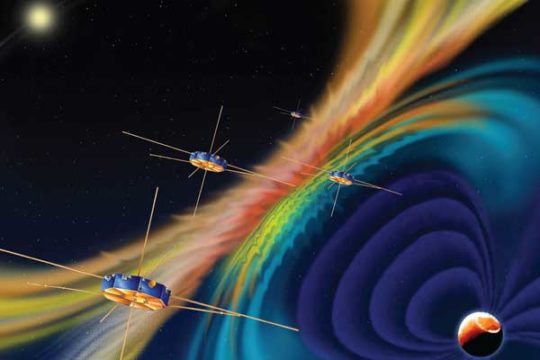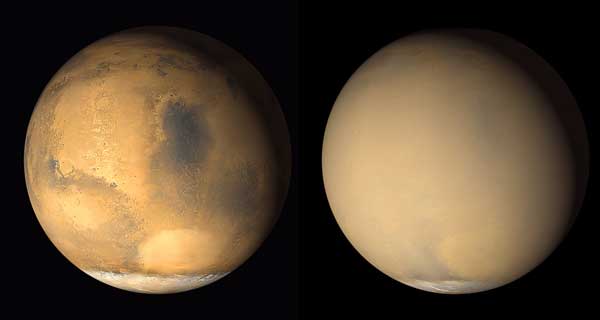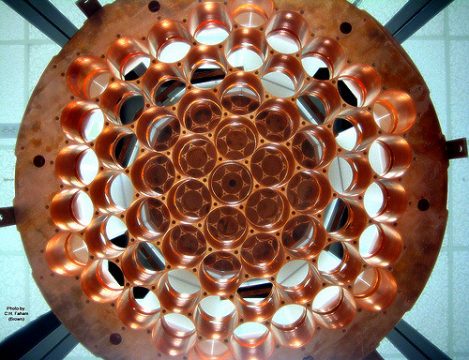Magnetism-Observing Mission Witnesses Reconnection
Magnetic fields surround Earth and guard it against magnetically borne particles from the Sun. Yet there’s a connection between Earth and Sun, one that’s not fully understood. Scientists know that the two fields interact via reconnection, when two sets of magnetic fields cross and connect in a way that sends particles shooting off in different directions. The process breaks the “rules” that govern charged particles, but indirect evidence in the 1980s confirmed that it nevertheless happens. But scientists haven’t been able to actually witness the process, complicating things like space weather prediction.
Now, the Magnetospheric Multiscale (MMS) mission — a quartet of spacecraft measuring radiation and magnetic fields from high Earth orbit — has directly confirmed reconnection. “Our data clearly show that electrons suddenly cease to follow magnetic fields and zoom off in another direction, corkscrewing and turning,” Jan Egedal (University of Wisconsin, Madison) says. For the first time, MMS is revealing what happens during reconnection on the subatomic level, enabling scientists to study the effects of this mysterious process.

NASA
Read more from the University of Wisconsin, Madison, press release.
Dust Storms Stir Up Martian Atmosphere, Aid Its Escape
Mars is losing its atmosphere. But while scientists had expected this loss to be dominated by solar activity, observations have shown that it instead follows the planet’s seasons. Nicholas Heavens (Hampton University and JPL-Caltech) and colleagues reported new analysis of Mars Reconnaissance Orbiter (MRO) data in Nature Astronomy, published online on January 22nd, that could explain why this is so.
When the Mars Climate Sounder instrument onboard MRO observed the last global dust storm that covered the Red Planet in 2007, it revealed a hundredfold increase in water vapor in the planet’s middle atmosphere, roughly 50 to 100 km (30 to 60 miles) high. Swirling dust storms appear to raise up water vapor, making hydrogen available to the upper atmosphere, where it is ultimately lost. The next Martian dust storm season is expected to begin this summer and last into early 2019. This time, MAVEN along with five other orbiters, will be available to confirm these observations with more detailed data.

NASA / JPL / MSSS
Read more in NASA’s press release.
Dark Matter Slower Than Expected
Experiments have yet to directly detect dark matter particles. Part of the difficulty is that we don’t know how fast dark matter travels — that matters because the speediest particles would be easiest to detect. Scientists have often assumed that the particles follow the Maxwell-Boltzmann distribution, with the same range of speeds as air molecules in a room: roughly speaking, some particles will move fast, some slow, but most will move at a medium pace.
However, a new study in Physical Review Letters by Herzog-Arbeitman (Princeton) and colleagues reveal problems with that assumption. They simulated the evolution of a Milky Way-like galaxy, tracking both the dark matter and the stars. The simulations show that the oldest stars have a range of speeds similar to the dark particles — and the older stars move more slowly than expected from a Maxwell-Boltzmann distribution. Slower particles would be more difficult to detect, so this result could affect how scientists interpret direct-detection experiments.

LUX / Sanford Underground Research Facility
Read more about the study and its implications in “Viewpoint: A Dark Matter Speedometer.”
 1
1
Comments
Esnuka
February 23, 2018 at 5:16 pm
An explanation to the expansion of the universe
a) Mass moves as a slipknot in the global aether –three-dimensional grid of elastic filaments
b) Electromagnetic energy is torsion in the grid
c) When there is enough torsion mass creates within a reticule, and global aether is compressed. The reticules are avoiding the knots to get undone.
d) When stars are losing mass, they are expanding the global aether
e) The expansion does not move a lot the other stars because the interaction has the quadratic relation v^2/c^2 –similar to kinetic energy but the opposite effect– so it looks the expansion is generated everywhere.
Global Physics theory was not designed to explain the expansion of the universe but it does.
https://molwick.com/en/astrophysics/045-dark-matter-rotation-galaxies.html#galaxias
You must be logged in to post a comment.
You must be logged in to post a comment.